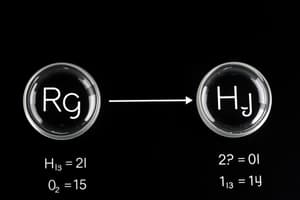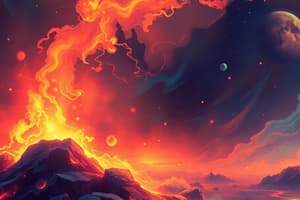Podcast
Questions and Answers
Which statement accurately describes the relationship between molar mass and the calculation of moles?
Which statement accurately describes the relationship between molar mass and the calculation of moles?
- Molar mass is independent of the amount of substance.
- Moles can be calculated by dividing mass by molar mass. (correct)
- The number of moles is always greater than the mass of the substance.
- One mole of a substance is equal to its mass in kilograms.
What distinguishes an empirical formula from a molecular formula?
What distinguishes an empirical formula from a molecular formula?
- Empirical formulas are always larger than molecular formulas.
- Empirical formulas only apply to ionic compounds.
- Molecular formulas cannot represent the true composition of a compound.
- Molecular formulas reflect actual atom counts, while empirical formulas show the simplest ratio. (correct)
Which of the following correctly defines isotopes?
Which of the following correctly defines isotopes?
- Atoms with identical mass numbers.
- Atoms that cannot exist in a stable form.
- Atoms of the same element with the same number of protons but different neutrons. (correct)
- Atoms with different atomic numbers.
Under what conditions do real gases deviate most from ideal gas behavior?
Under what conditions do real gases deviate most from ideal gas behavior?
Which of the following best describes the electron configuration of an atom?
Which of the following best describes the electron configuration of an atom?
Which type of bond involves the sharing of electrons between two atoms?
Which type of bond involves the sharing of electrons between two atoms?
How does the ideal gas law relate the variables of a gas?
How does the ideal gas law relate the variables of a gas?
What is a key characteristic of metallic bonding?
What is a key characteristic of metallic bonding?
Which of the following accurately describes an endothermic reaction?
Which of the following accurately describes an endothermic reaction?
Which principle explains how a system at equilibrium will respond to an increase in temperature?
Which principle explains how a system at equilibrium will respond to an increase in temperature?
How does Hess's Law relate to enthalpy changes?
How does Hess's Law relate to enthalpy changes?
Which factor does NOT affect the equilibrium constant K of a reaction?
Which factor does NOT affect the equilibrium constant K of a reaction?
In a redox reaction, which of the following is true regarding oxidizing agents?
In a redox reaction, which of the following is true regarding oxidizing agents?
Which statement about solutions is incorrect?
Which statement about solutions is incorrect?
Which of the following accurately describes a galvanic cell?
Which of the following accurately describes a galvanic cell?
What is the key characteristic of colligative properties?
What is the key characteristic of colligative properties?
Flashcards
Mole Concept
Mole Concept
A mole is a unit of amount of substance containing Avogadro's number of entities (atoms, molecules, ions).
Molar Mass
Molar Mass
The mass of one mole of a substance in grams.
Atomic Number (Z)
Atomic Number (Z)
The number of protons in an atom.
Stoichiometry
Stoichiometry
Signup and view all the flashcards
Ideal Gas Law
Ideal Gas Law
Signup and view all the flashcards
Limiting Reactant
Limiting Reactant
Signup and view all the flashcards
Covalent Bond
Covalent Bond
Signup and view all the flashcards
Ionic Bond
Ionic Bond
Signup and view all the flashcards
First Law of Thermodynamics
First Law of Thermodynamics
Signup and view all the flashcards
Equilibrium Constant (K)
Equilibrium Constant (K)
Signup and view all the flashcards
Exothermic reaction
Exothermic reaction
Signup and view all the flashcards
Redox Reaction
Redox Reaction
Signup and view all the flashcards
Enthalpy (H)
Enthalpy (H)
Signup and view all the flashcards
Le Chatelier's Principle
Le Chatelier's Principle
Signup and view all the flashcards
Solutions
Solutions
Signup and view all the flashcards
Galvanic cell
Galvanic cell
Signup and view all the flashcards
Study Notes
Stoichiometry
- Stoichiometry deals with quantitative relationships between reactants and products in a chemical reaction.
- It involves calculating the amounts of substances involved, using balanced chemical equations.
- Key concepts include:
- Mole concept: The mole is a unit of amount of substance. One mole of any substance contains Avogadro's number of entities (atoms, molecules, ions).
- Molar mass: The mass of one mole of a substance in grams.
- Empirical formula: The simplest whole-number ratio of atoms in a compound.
- Molecular formula: The actual number of atoms of each element in a molecule.
- Essential calculations include:
- Calculating moles from mass and molar mass.
- Determining the limiting reactant in a reaction.
- Calculating the theoretical yield and percentage yield of a reaction.
- Calculating the concentration of solutions (e.g., molarity, molality).
Atomic Structure
- Atoms consist of a nucleus containing protons and neutrons, with electrons orbiting the nucleus.
- Atomic number (Z) represents the number of protons in an atom. Mass number (A) is the sum of protons and neutrons.
- Isotopes are atoms of the same element with the same atomic number but different mass numbers (different number of neutrons).
- Electron configuration describes how electrons are distributed in different energy levels and sublevels within an atom.
- The periodic table organizes elements based on their atomic number and electronic configuration, revealing trends in their properties.
Chemical Bonding
- Chemical bonds hold atoms together to form molecules or compounds.
- Covalent bonds involve sharing of electrons between atoms.
- Ionic bonds involve transfer of electrons between atoms, leading to the formation of ions (cations and anions).
- Metallic bonding involves delocalized electrons shared among many metal atoms.
- Properties of compounds depend on the type and strength of the bonds.
Gaseous State
- Gases are characterized by their compressibility and ability to fill the container they occupy.
- Ideal gas law: PV = nRT, where P is pressure, V is volume, n is the number of moles, R is the ideal gas constant, and T is the temperature in Kelvin.
- Real gases deviate from ideal gas behavior at high pressures and low temperatures.
- Gas laws (Boyle's law, Charles' law, Gay-Lussac's law) describe the relationships between pressure, volume, and temperature of gases.
- Stoichiometry of gaseous reactions involves using the mole concept and the ideal gas law.
Thermodynamics
- Thermodynamics deals with energy changes in chemical reactions.
- The first law of thermodynamics: Energy can be neither created nor destroyed, only transformed.
- Enthalpy (H) is a measure of heat content of a system at constant pressure.
- Exothermic reactions release heat (ΔH is negative).
- Endothermic reactions absorb heat (ΔH is positive).
- Hess's Law states that the enthalpy change for a reaction is the same whether it occurs in one step or several steps.
Equilibrium
- Equilibrium is a state where the forward and reverse rates of a reaction are equal, and the concentration of reactants and products remain constant.
- Law of mass action defines the relationship between the concentrations of reactants and products at equilibrium.
- The equilibrium constant (K) quantifies the extent to which a reaction proceeds to completion.
- Le Chatelier's principle describes how the position of equilibrium shifts in response to changes in conditions (temperature, pressure, concentration).
Redox Reactions
- Redox reactions involve the transfer of electrons between reactants.
- Oxidation is the loss of electrons and reduction is the gain of electrons.
- Oxidizing agents cause oxidation, reducing agents cause reduction.
- Balancing redox reactions typically involves the method of half-reactions or ion-electron method.
- Applications of redox reactions in various fields, including electrochemistry.
Solutions
- Solutions are homogeneous mixtures of two or more substances.
- Solvent and solute.
- Concentration expresses the amount of solute present in a given amount of solvent or solution.
- Colligative properties of solutions depend on the number of solute particles, not their identity.
- Examples include vapor pressure lowering, boiling point elevation, freezing point depression, osmotic pressure.
Electrochemistry
- Electrochemistry deals with the interconversion of chemical and electrical energy.
- Galvanic cells (voltaic cells) produce electrical energy from spontaneous redox reactions.
- Electrolytic cells use electrical energy to drive non-spontaneous redox reactions.
- Electrodes, electrodes potentials, cell potentials, Nernst Equation.
- Applications of electrochemistry in batteries, corrosion, and electroplating, etc.
Organic Chemistry
- Brief overview of basic functional groups (e.g., alkanes, alkenes, alkynes, alcohols, aldehydes, ketones, carboxylic acids).
- Basic nomenclature and isomerism.
- Important types of reactions (e.g., addition, substitution, elimination).
- Understanding the fundamental concepts with respect to the application on Neet exam.
Chemical Kinetics
- Reaction rates and factors affecting them (temperature, concentration, catalysts).
- Rate laws and order of reactions.
- Integrated rate laws (zero, first, and second order).
- Effect of temperature on reaction rate (Arrhenius equation).
- Mechanisms of reactions.
- Catalysis.
Surface Chemistry
- Adsorption, absorption, colloids, emulsions, and surfactants.
- Applications in catalysis, medicine, water treatment, etc.
Studying That Suits You
Use AI to generate personalized quizzes and flashcards to suit your learning preferences.
Description
Test your knowledge of stoichiometry and atomic structure concepts. This quiz covers fundamental calculations involving moles, molar mass, and the characteristics of atoms. Ideal for chemistry students seeking to reinforce their understanding of relationships in chemical reactions.




